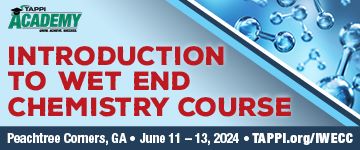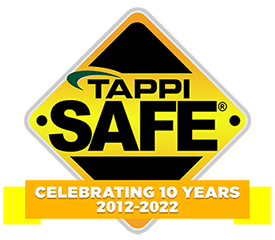 Search
Search
Use the search bar or filters below to find any TAPPI product or publication.
Filters
Content Type
Publications
Level of Knowledge
Collections
Journal articles

Magazine articles

Peracetate/singlet oxygen chemistry used in post-bleaching of kraft pulp as a practical oxidant for paper machines, TAPPI Journal May 2021
ABSTRACT: The use of a novel sodium peracetate/singlet oxygen chemistry for brightening bleached kraft pulp shows exciting potential for technical performance, supply logistics, safety, and cost reduction. Potential chemical carryover to the paper machine raises questions about whether peracetate will impact paper machine performance, such as metal corrosion, useful press felt life, and interference with existing biocide programs or paper machine chemistry. Sodium peracetate/singlet oxygen chemistry can be used in high-density storage chests for brightening/whitening and to increase color stability. Any oxidant used directly before the paper machine has the possibility of impacting paper machine operations. Traditional oxidants used in bleaching, such as chlorine dioxide and hydrogen peroxide, are known to cause corrosion on machinery metals and press felts. Hydrogen peroxide residuals can interfere with common biocide programs. Traditional oxidants used in biocide treatments themselves significantly degrade press felt life when the rule-of-thumb concentration thresholds are exceeded. Sodium peracetate is evaluated in this paper for its impact on nylon press felt fiber degradation, metal corrosion, and interference with typical biocide programs.Laboratory results indicate that sodium peracetate/singlet oxygen chemistry is less corrosive than chlorine, bromine, and hydrogen peroxide on press felt nylon fiber and can therefore be used at higher levels than those chemistries to increase brightness without increasing negative downstream impact. Sodium peracetate can also be used with current biocide programs without negative impacts such as consumptive degradation. Higher residuals of peracetate going to the paper machine may be useful as a biocide itself and can complement existing programs, allowing those programs to stay within their safe operating levels and thereby extend press felt useful life.
Journal articles

Magazine articles

Mechanical modification of softwood pulp fibers using a novel lightweight vertical bar plate, TAPPI Journal April 2021
ABSTRACT: Refiner plates made using sand casting have a draft angle, which results in a trapezoidal bar shape. These trapezoidal bar plates have a limited throughput compared to the vertical bar plates, and eventually the edges of the bars become dull, resulting in longer time to reach the target freeness and shorter service life. The new light-weight refiner plate with a bar insertion method into a plate base was developed by selecting an aluminium-based alloy as the plate base material and a stainless steel alloy with high wear resistance as the bar material. The light-weight plate with sharp bar edges was very effective in reducing refining energy by reaching the target freeness faster than the sand-cast bar plate. Finally, the lightweight sharp bar plate, which weighed only about half the weight of the cast bar plate, was expected to significantly contribute to easy replacement, improved paper quality, and larger throughput without excessive loss of fiber length.
Journal articles

Magazine articles

TAPPI Journal 2016 Best Research Paper Award: Mining Big Dat
TAPPI Journal 2016 Best Research Paper Award: Mining Big Data to improve pulping and papermaking operations, TAPPI JOURNAL April 2017
Journal articles

Magazine articles

Multiple recycling of paperboard: Paperboard characteristics and maximum number of recycling cycles— Part I: Multiple recycling of corrugated base paper, TAPPI Journal November 2019
ABSTRACT: Paper for recycling is an important fiber source for the production of corrugated base paper. The change in production capacity toward more and more packaging papers affects the composition of paper for recy-cling and influences the paper quality. This research project investigated the influence of the multiple recycling of five different corrugated base papers (kraftliner, neutral sulfite semichemical [NSSC] fluting, corrugating medium, testliner 2, and testliner 3) on suspen-sion and strength properties under laboratory conditions. The corrugated board base papers were repulped in a low consistency pulper and processed into Rapid-Köthen laboratory sheets. The sheets were then recycled up to 15 times in the same process. In each cycle, the suspension and the paper properties were recorded. In particular, the focus was on corrugated board-specific parameters, such as short-span compression test, ring crush test, corrugat-ing medium test, and burst. The study results indicate how multiple recycling under laboratory conditions affects fiber and paper properties.
Journal articles

Magazine articles

Editorial: Diverse content characterizes PaperCon 2019, TAPPI Journal November 2019
ABSTRACT: PaperCon 2019 was held from May 5-8 in Indianapolis, IN. Many of us visiting Indianapolis had little or no perception of the area beyond, of course, race cars and good sports teams. We also found a lovely, walkable downtown with a myriad of restaurants, parks, historic sites, and state government. As with the diverse offerings of PaperCon 2019’s host city of Indianapolis, the conference technical program was exceptionally broad this year. In this special issue of TAPPI Journal, we share both the breadth and quality of the content presented at PaperCon 2019 through peer-reviewed papers from the conference, as described below.
Journal articles

Magazine articles

Removal of phthalate from papermaking wastewater by MIL-101(Fe) in the presence of persulfate, TAPPI JOURNAL March 2018
Removal of phthalate from papermaking wastewater by MIL-101(Fe) in the presence of persulfate, TAPPI JOURNAL March 2018
Journal articles

Magazine articles

Life cycle carbon analysis of packaging products containing purposely grown nonwood fibers: A case study on the use of switchgrass pulp for linerboard and corrugating medium, TAPPI Journal March 2024
ABSTRACT: Sustainability is driving innovation in the pulp and paper industry to produce goods with lower carbon footprints. Although most of the efforts are currently focused on increasing energy efficiency or switching to renewable fuels, the attention toward alternative feedstocks has increased in recent years. Claims of nonwood fibers requiring lower use of chemicals and energy than wood fibers, along with negative consumer perceptions of tree felling, are helping purposely grown nonwoods to gain market share. The potential nonwood fiber environmental superiority over virgin or recycled wood fibers remains controversial and is often driven more by emotion and public perception rather than facts. This paper estimates the carbon footprint of corrugating medium and linerboard containing switchgrass pulp compared to analogous wood-based materials. The study includes a life cycle carbon analysis spanning from cradle to gate, which comprises stages for fiber production, pulping, papermaking, and corresponding transportation. Carbon footprints for virgin linerboard, recycled linerboard, virgin medium, and recycled medium were estimated at around 510, 620, 460, and 670 kg carbon dioxide equivalent per metric ton (kg CO2eq/t), respectively. Replacing 30% of the virgin or recycled material with switchgrass pulp translated into carbon footprint increases of around 60%, 45%, 62%, and 38%, respectively. Thus, for the proposed case study, the results suggest that switchgrass-based medium and linerboard can present a higher carbon footprint than products made from virgin and recycled wood fibers. The main driver is the production of nonwood mechanical pulp.This study was designed to mitigate part of the uncertainty around the environmental sustainability of medium and linerboard made from the selected purposely grown nonwood fibers.
Journal articles

Magazine articles

Life cycle carbon analysis of packaging products containing nonwood residues: A case study on linerboard and corrugating medium, TAPPI Journal March 2024
ABSTRACT: Circularity is creating momentum toward utilizing waste feedstock in a myriad of applications. The paper industry is not an exception to this trend, and packaging products made from agricultural or agro-industrial residues are receiving more attention now than ever. Additionally, negative consumer perceptions of tree felling are accelerating the acceptance of these fibers. Nevertheless, adopting these residues raises the issue of whether they constitute a better alternative to fight climate change than wood. Answering this question is imperative to ensure that pledges to reduce carbon footprints across the industry are fulfilled. This paper aims to estimate the carbon footprint of corrugating medium and linerboard containing wheat straw and sugarcane bagasse pulp compared to analogous wood-based materials. The goal was also to understand how methodological decisions to allocate emissions to nonwood residues can affect the results. This study includes a life cycle carbon analysis spanning from cradle to grave, which comprises stages for residue production, pulping, paper-making, waste management, and corresponding transportation. For the proposed case study, the results suggest that straw- and bagasse-based medium and linerboard can present a higher carbon footprint than products made from virgin and recycled wood fibers. The main driver is the production of nonwood chemimechanical pulp. In addition, the lower capacity of nonwood residues to be recycled increases the overall impact. Finally, decisions around emissions allocation highly influence the results. This study helps mitigate part of the uncertainty around the environmental sustainability of corrugating medium and linerboard made from the selected nonwood residues.
Journal articles

Magazine articles

Alkyl ketene dimer (AKD) sized paper reversion due to oxidative photodegradation, TAPPI Journal January 2024
ABSTRACT: Alkyl ketene dimer (AKD) is a sizing agent used in papermaking to increase the resistance of paper-board towards water penetration. The acquired hydrophobic property of the paper can be reversed due to the instability of the sizing agent. It is broadly known that AKD size reversion is due to migration, poor orientation, masking, or hydrolysis of the sizing agent. Unfortunately, the environmental parameters that cause this chemical instability are not well understood. Thus, the conditions that initiate or catalyze AKD size reversion and the mechanisms of AKD size reversion under different environmental conditions need to be investigated. In this study, six different experimental setups were used to investigate how temperature, daylight, fluorescent light, oxygen, and ultraviolet (UV) light affect AKD size reversion. Cobb values and pyrolysis gas chromatography-mass spectrometry (py-GCMS) results show that AKD size reversion is due to the degradation of the chemical in the presence of light and oxygen; temperature variations were found to accelerate reversion in the presence of light and oxygen. The oxidative photodegradation mechanism of the sizing agent is explored, and a possible mechanism is proposed.
Journal articles

Magazine articles

Quantification of hardwood black liquor contamination in pine black liquor, TAPPI Journal February 2024
ABSTRACT: The presence of hardwood black liquor contamination in pine black liquor can negatively impact brownstock washer and evaporator operation, as well as reduce soap separation and yield. It is also believed to negatively impact commercial kraft lignin production. It was desired to develop a method of quantitatively determining the amount of low-level hardwood liquor contamination in pine black liquor. A method employing pyrolysis-gas chromatography mass spectrometry (py-GCMS) was developed to perform the desired measurement. Laboratory cooks with carefully controlled blends of pine and hardwood chips were prepared, and the resulting liquor was measured using this technique. Additionally, samples of pine and hardwood black liquors were blended in known quantities and analyzed. All these samples were submitted as blind samples. The resulting analysis suggests the py-GCMS method was able to accurately determine the level of hardwood contamination between 1% to 10% hardwood liquor using a low-level calibration curve prepared with coniferyl alcohol and sinapyl alcohol as standards.






